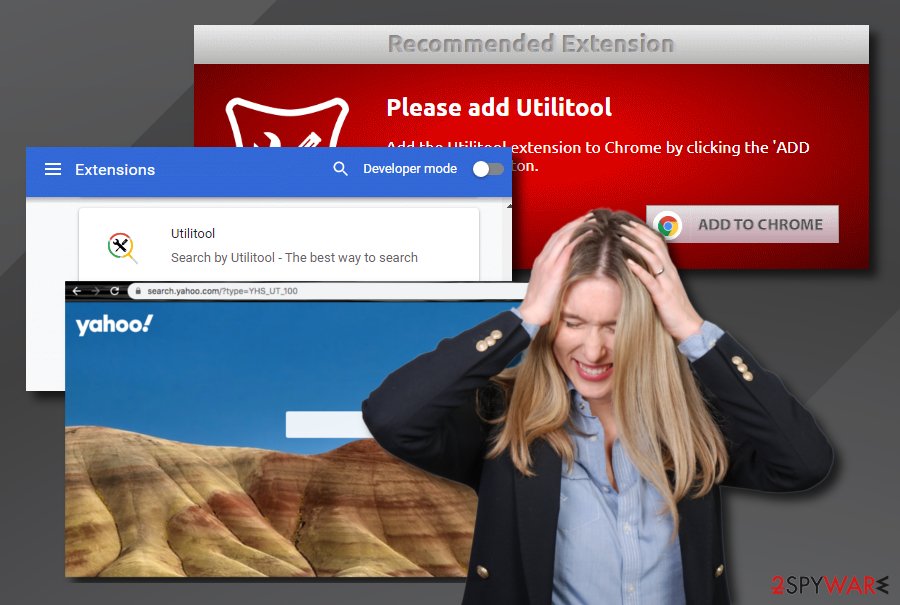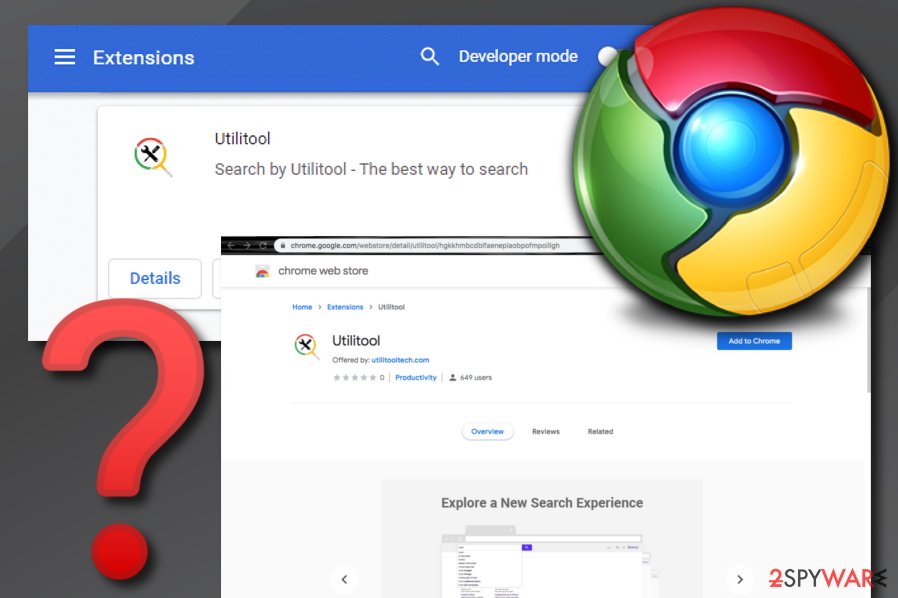Utilitool (Simple Removal Guide) - Free Instructions
Utilitool Removal Guide
What is Utilitool?
Utilitool – a browser hijacker that redirects to Yahoo while trying to enter its feed.utilitooltech.com fake search provider

Utilitool is described as a browser-hijacking product that provides search requests from Yahoo.com.[1] The PUP aims to modify web browser settings such as the default search provider, homepage, and new tab URL. Continuously, you can install Utilitool Chrome extension on the official Google Chrome Web Store. Even though this product can be downloaded legitimately and includes a nice description, it cannot be trusted as it might also come through a software bundle. Even though the browser hijacker[2] is advertised as a handy tool for entering news sources, typing search queries, and receiving other information, Utilitool virus is a useless product as it just takes you to a legitimate search engine while entering feed.utilitooltech.com. So, you can just use the Yahoo search engine instead of downloading this program and getting your web browser hijacked, experiencing intrusive advertising and redirecting sessions.
| Name | Utilitool |
|---|---|
| Type | Browser hijacker |
| Category | Potentially unwanted program |
| Search engine | The browser hijacker uses the feed.utilitooltech.com search engine for hijacking the web browser which drops the user directly to yahoo.com |
| Downloading | You can download and install the suspicious extension from the Google Chrome Web Store or you can get it unexpectedly bundled with freeware and shareware |
| Target(s) | This potentially unwanted program is mostly found on Google Chrome but can also target other browser apps such as Internet Explorer, Mozilla Firefox, Microsoft Edge, and Safari |
| Elimination | You can terminate the browser hijacker with the help of manual step-y-step guidelines or by purchasing trustworthy antimalware software |
| Fix tip | If your system has experienced any alterings during the activity period of the browser hijacker, try reversing the changes with the help of FortectIntego |
Multiple unwanted activities can be promoted by Utilitool. First of all, you will experience browser changes in its settings where you will receive the bogus extension that will be responsible for all the further tasks. Afterward, your browser might start struggling to deal with an excessive amount of advertisements.
Utilitool might provide you with irrelevant deals while you are browsing online and encourage you to purchase useless computer security products and services. As a result, you will spend your money on a useless product that you will regret later on. So, do not waste your money and deny all the offers that come from this third-party app.
Furthermore, advertising that comes from Utilitool might decrease your browsing quality as your sessions are likely to experience decreased speed and quality of browsing sessions. This happens because the browser hijacker starts eating up your computer's resources such as the power and energy of your CPU[3] and GPU.
In addition, Utilitool might force redirects to affiliate domains where you might meet additional offers or be spammed with more advertising content. However, sometimes, you might be taken to a location that is filled with malware. This way a dangerous parasite might end up on your computer system and cause severe damage.

Continuously, Utilitool could be able to collect non-personal information that is related to your web browser and online sessions. Such data often refers to recently visited websites, hyperlinks and adverts clicked, bookmarks saved, offers and deals searched, your web browser type, IP address, and geographic location.
Utilitool might collect such type of information to share it with other parties and receive income. However, this data can also be recorded due to the goal to get you involved in targeted advertising campaigns. Afterward, the developers can provide adverts that claim to suit your needs even if they are truly misleading.
To add, Utilitool might not come to the computer system allow. This browser hijacker can bring others of its kind or other potentially unwanted programs such as adware. This way your computer system will be overloaded by potentially unexpected cyber threats and your browser will experience a higher load of intrusive activities.
Spotting Utilitool randomly on your computer system signifies that your computer system is not protected at a good level or you have made mistakes somewhere in a software downloading process, etc. If you cannot recall installing this extension on your own, you should make sure that you secure your computer system with antimalware software properly.
However, first of all, you should remove Utilitool so it would not bother you anymore. This third-party app can be easily erased with automatical removal utilities, just pick a trustworthy program for the process. Also, if you have discovered any system alterings, you can try recovering the touched areas with the help of software such as FortectIntego.
Utilitool removal can also be performed with the help of manual guiding steps. Remember, that you will be responsible for cleaning both your operating system and web browsers such as Google Chrome, Mozilla Firefox, Internet Explorer, Microsoft Edge, or Safari from suspicious objects that were added by the adware program.

Browser hijackers get delivered in software bundles
Even though some potentially unwanted programs can infiltrate computer systems through official downloads on the Google Chrome Web Store, this is not the main way how the PUPs appear on a particular machine. According to Virusai.lt specialists,[4] browser hijackers are usually bundled with freeware and shareware.
This happens when the user is completing a download himself and misses some crucial downloading steps. Continuously, those who have set their installing configuration to “Recommend” have a much higher chance of receiving a potentially unwanted program than those who have already opted for the “Advanced” settings.
Furthermore, browser hijackers and potentially unwanted content can get delivered with PDF converters and download managers that users download from secondary websites such as download.com, cnet.com, softonic.com, and soft32.com. A piece of advice would be to get all of your products and services from reliable sources only.
In addition, some PUPs can come camouflaged as fake flash player updates or be injected into advertisements and hyperlinks. While you are browsing the Internet sphere, you have to be aware of questionable content that runs your way. Also, pay attention to the warnings that your antivirus program throws you.
Removal instructions for Utilitool extension
If you have been dealing with the browser hijacker lately and your web browsers have experienced unwanted changes, it is time for you to remove Utilitool permanently from your computer system and browser apps.
Utilitool removal can be performed with the help of automatical software that is capable of detecting the PUP and eliminating all the additional products that were brought by the help of the browser hijacker.
Also, you can uninstall Utilitool virus with the help of manual step-by-step instructions that have been added to the end of this writing. There you will learn how to get rid of unwanted apps from your OS and clean your web browsers such as Google Chrome, Mozilla Firefox, Internet Explorer, Microsoft Edge, and Safari from bogus extensions.
You may remove virus damage with a help of FortectIntego. SpyHunter 5Combo Cleaner and Malwarebytes are recommended to detect potentially unwanted programs and viruses with all their files and registry entries that are related to them.
Getting rid of Utilitool. Follow these steps
Uninstall from Windows
To delete questionable applications from your Windows machine, use the below-provided guidelines.
Instructions for Windows 10/8 machines:
- Enter Control Panel into Windows search box and hit Enter or click on the search result.
- Under Programs, select Uninstall a program.

- From the list, find the entry of the suspicious program.
- Right-click on the application and select Uninstall.
- If User Account Control shows up, click Yes.
- Wait till uninstallation process is complete and click OK.

If you are Windows 7/XP user, proceed with the following instructions:
- Click on Windows Start > Control Panel located on the right pane (if you are Windows XP user, click on Add/Remove Programs).
- In Control Panel, select Programs > Uninstall a program.

- Pick the unwanted application by clicking on it once.
- At the top, click Uninstall/Change.
- In the confirmation prompt, pick Yes.
- Click OK once the removal process is finished.
Delete from macOS
Remove items from Applications folder:
- From the menu bar, select Go > Applications.
- In the Applications folder, look for all related entries.
- Click on the app and drag it to Trash (or right-click and pick Move to Trash)

To fully remove an unwanted app, you need to access Application Support, LaunchAgents, and LaunchDaemons folders and delete relevant files:
- Select Go > Go to Folder.
- Enter /Library/Application Support and click Go or press Enter.
- In the Application Support folder, look for any dubious entries and then delete them.
- Now enter /Library/LaunchAgents and /Library/LaunchDaemons folders the same way and terminate all the related .plist files.

Remove from Microsoft Edge
Delete unwanted extensions from MS Edge:
- Select Menu (three horizontal dots at the top-right of the browser window) and pick Extensions.
- From the list, pick the extension and click on the Gear icon.
- Click on Uninstall at the bottom.

Clear cookies and other browser data:
- Click on the Menu (three horizontal dots at the top-right of the browser window) and select Privacy & security.
- Under Clear browsing data, pick Choose what to clear.
- Select everything (apart from passwords, although you might want to include Media licenses as well, if applicable) and click on Clear.

Restore new tab and homepage settings:
- Click the menu icon and choose Settings.
- Then find On startup section.
- Click Disable if you found any suspicious domain.
Reset MS Edge if the above steps did not work:
- Press on Ctrl + Shift + Esc to open Task Manager.
- Click on More details arrow at the bottom of the window.
- Select Details tab.
- Now scroll down and locate every entry with Microsoft Edge name in it. Right-click on each of them and select End Task to stop MS Edge from running.

If this solution failed to help you, you need to use an advanced Edge reset method. Note that you need to backup your data before proceeding.
- Find the following folder on your computer: C:\\Users\\%username%\\AppData\\Local\\Packages\\Microsoft.MicrosoftEdge_8wekyb3d8bbwe.
- Press Ctrl + A on your keyboard to select all folders.
- Right-click on them and pick Delete

- Now right-click on the Start button and pick Windows PowerShell (Admin).
- When the new window opens, copy and paste the following command, and then press Enter:
Get-AppXPackage -AllUsers -Name Microsoft.MicrosoftEdge | Foreach {Add-AppxPackage -DisableDevelopmentMode -Register “$($_.InstallLocation)\\AppXManifest.xml” -Verbose

Instructions for Chromium-based Edge
Delete extensions from MS Edge (Chromium):
- Open Edge and click select Settings > Extensions.
- Delete unwanted extensions by clicking Remove.

Clear cache and site data:
- Click on Menu and go to Settings.
- Select Privacy, search and services.
- Under Clear browsing data, pick Choose what to clear.
- Under Time range, pick All time.
- Select Clear now.

Reset Chromium-based MS Edge:
- Click on Menu and select Settings.
- On the left side, pick Reset settings.
- Select Restore settings to their default values.
- Confirm with Reset.

Remove from Mozilla Firefox (FF)
To erase suspicious components from Mozilla firefox, apply these instructions.
Remove dangerous extensions:
- Open Mozilla Firefox browser and click on the Menu (three horizontal lines at the top-right of the window).
- Select Add-ons.
- In here, select unwanted plugin and click Remove.

Reset the homepage:
- Click three horizontal lines at the top right corner to open the menu.
- Choose Options.
- Under Home options, enter your preferred site that will open every time you newly open the Mozilla Firefox.
Clear cookies and site data:
- Click Menu and pick Settings.
- Go to Privacy & Security section.
- Scroll down to locate Cookies and Site Data.
- Click on Clear Data…
- Select Cookies and Site Data, as well as Cached Web Content and press Clear.

Reset Mozilla Firefox
If clearing the browser as explained above did not help, reset Mozilla Firefox:
- Open Mozilla Firefox browser and click the Menu.
- Go to Help and then choose Troubleshooting Information.

- Under Give Firefox a tune up section, click on Refresh Firefox…
- Once the pop-up shows up, confirm the action by pressing on Refresh Firefox.

Remove from Google Chrome
To reverse dubious changes in Google Chrome, complete the following guiding steps.
Delete malicious extensions from Google Chrome:
- Open Google Chrome, click on the Menu (three vertical dots at the top-right corner) and select More tools > Extensions.
- In the newly opened window, you will see all the installed extensions. Uninstall all the suspicious plugins that might be related to the unwanted program by clicking Remove.

Clear cache and web data from Chrome:
- Click on Menu and pick Settings.
- Under Privacy and security, select Clear browsing data.
- Select Browsing history, Cookies and other site data, as well as Cached images and files.
- Click Clear data.

Change your homepage:
- Click menu and choose Settings.
- Look for a suspicious site in the On startup section.
- Click on Open a specific or set of pages and click on three dots to find the Remove option.
Reset Google Chrome:
If the previous methods did not help you, reset Google Chrome to eliminate all the unwanted components:
- Click on Menu and select Settings.
- In the Settings, scroll down and click Advanced.
- Scroll down and locate Reset and clean up section.
- Now click Restore settings to their original defaults.
- Confirm with Reset settings.

Delete from Safari
Remove unwanted extensions from Safari:
- Click Safari > Preferences…
- In the new window, pick Extensions.
- Select the unwanted extension and select Uninstall.

Clear cookies and other website data from Safari:
- Click Safari > Clear History…
- From the drop-down menu under Clear, pick all history.
- Confirm with Clear History.

Reset Safari if the above-mentioned steps did not help you:
- Click Safari > Preferences…
- Go to Advanced tab.
- Tick the Show Develop menu in menu bar.
- From the menu bar, click Develop, and then select Empty Caches.

After uninstalling this potentially unwanted program (PUP) and fixing each of your web browsers, we recommend you to scan your PC system with a reputable anti-spyware. This will help you to get rid of Utilitool registry traces and will also identify related parasites or possible malware infections on your computer. For that you can use our top-rated malware remover: FortectIntego, SpyHunter 5Combo Cleaner or Malwarebytes.
How to prevent from getting browser hijacker
Stream videos without limitations, no matter where you are
There are multiple parties that could find out almost anything about you by checking your online activity. While this is highly unlikely, advertisers and tech companies are constantly tracking you online. The first step to privacy should be a secure browser that focuses on tracker reduction to a minimum.
Even if you employ a secure browser, you will not be able to access websites that are restricted due to local government laws or other reasons. In other words, you may not be able to stream Disney+ or US-based Netflix in some countries. To bypass these restrictions, you can employ a powerful Private Internet Access VPN, which provides dedicated servers for torrenting and streaming, not slowing you down in the process.
Data backups are important – recover your lost files
Ransomware is one of the biggest threats to personal data. Once it is executed on a machine, it launches a sophisticated encryption algorithm that locks all your files, although it does not destroy them. The most common misconception is that anti-malware software can return files to their previous states. This is not true, however, and data remains locked after the malicious payload is deleted.
While regular data backups are the only secure method to recover your files after a ransomware attack, tools such as Data Recovery Pro can also be effective and restore at least some of your lost data.
- ^ Yahoo!. Wikipedia. The free encyclopedia.
- ^ What are browser hijackers?. Norton. Internet Security.
- ^ Jon Martindale. What is a CPU?. Digital Trends. Computing.
- ^ Virusai.lt. Virusai. Security and spyware news.























